Hello, and welcome.
Thank you for your response to last week’s post ‘Embers’ which took you on a walk up the hill with me; it really is good to have your company and to hear from you. And as the weeks go by, it’s great to recognise your names as you join me by subscribing. This feels like a good space to grow into and as you’ll see, I can share much more with you than social media facilitates.
I would have loved to make a return visit and immerse myself once again in those sublime blaeberry autumn tints, but we had an exceptionally wet weekend and this week it’s way too windy to even think about close up photography half way up a hill. I’m just hoping that the leaves will hang on. Typically today is calm and clear but I have an online meeting scheduled…
Monday afternoon was the best of it and I set off to look into the water but got somewhat distracted by the afternoon light on the trees. Nonetheless, the image I’ve chosen to include above is one of water which fits the theme of wet and is windy through its distortion of line and sense of movement. I always find in these twisting images echoes of the complex times we live in and try to navigate. Creativity is again providing me with a place of ease which I value greatly; you may recognise this place as important too.
My writing below considers the different ways I have found to look at this place and how water, and the states that it takes, continues to shape my vision. I hope you enjoy reading it.
A Corrected View: 3 Ways of Seeing
Now the day starts late, and ends early. I’m glad to have been able to climb that hill on the previous Sunday. It's a time of year when it feels important not to fritter away a good day.
This time round, Sunday wears a different face. I wake to a percussion of drips outside the window, and bass notes of heavy rain on the roof. It may be unseasonably warm in parts of England, but much of Scotland has by now seen 36 hours of rain, with the attendant problems it causes.
As cloud masks the hills, I start thinking about what I can see. Vision is something I’ve been contemplating for a while - how we see, as much as what we choose to look at.
We have become accustomed to seeing photographs and film where everything is sharp. We have wide angle lenses and sharpening software. It’s easy to think this is how it should be. It certainly influenced my own photography for many years, yet our natural vision only holds maximum detail in the centre and blurs the periphery. The change for me began when I first bought a macro lens and discovered just how atmospheric a limited depth of field could be. And then water accelerated it, its movement and volume creating a range of possible degrees of blur.
I can now recognise 3 ways that I look at the world:
Sharp, influenced by what I saw others do. This tends to recur when I am in a new place and lose my footing in its novelty, but otherwise I have largely left it behind. During my first autumn and winter here, I made sharp images of the trees.
Selective; finding my own vision and voice. For some time I hung onto the need for some part of an image to stay in focus and it’s something I touched on in a Q&A after a short talk at the On Landscape ‘Meeting of Minds’ conference back in 2018.
But over this year, a third way has emerged. I have begun to relax my grip further, and allow my work to be increasingly fluid. Soft reconnects me with my own natural vision. It has come from looking at water here, still in contrast to the movement that I played with on the River Dove. In focusing selectively I am introduced to blur, a byproduct of using a 200mm lens in a way that was probably not envisaged by its maker. Over time, these slippery lines and shapes morph through distortion into subject.
I began to sample colour and light on the land, employing the techniques that I use with water. At first this had no use other than as a note on the day. And then as I thought about the forms that water takes, I made the connection with vapour. It came as I watched bubbles of winter air finding their way between the ice and the water. And then these newly soft images reached into mixed media as colour grounds, and more boldly began asking that I consider them in their own right.
In thinking about this way of seeing, it dawned on me that my vision has always been defined by a lens: first of my glasses, then a camera. I have begun to question this corrected view and to explore my home place through these increasingly soft and fluid images. This is my true way of seeing. Aside from being a good student, the thing that marked me out as a child was being short sighted. I’ll never be able to lie in bed at night and look out at the stars, but perhaps for now I have found some compensation. Blur has become a means of inviting permeability, of buffering, of regaining stasis.
Having wrapped my head around this direction of travel, I can now look at the various images I’ve made which I initially regarded as ‘this’ and ‘that’ and find connective tissue. There are parallels between subject and form. The complex patterns of birch trees are echoed in the fractal branching of lichen that litters the ground and finds its way into the pools. And yes, the trees are dressed in lichen too.

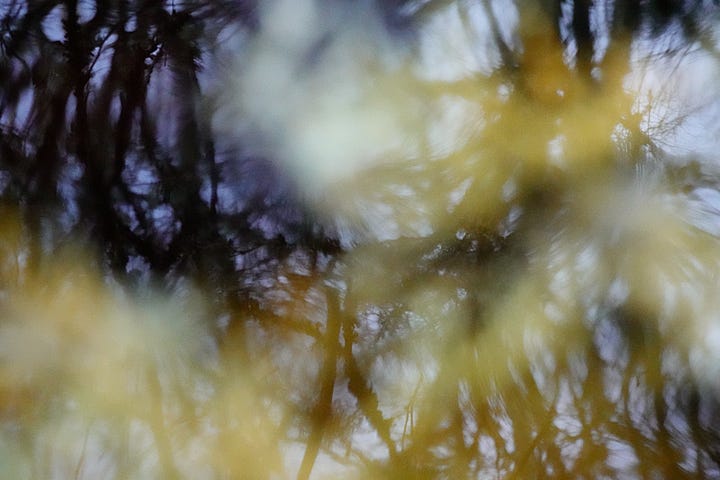
At the moment I have to resist my tendency to overcomplicate mixed media. It’s a very different way of working, and I can be too much ‘tree’. I’ve been photographing for so long now that it is instinctive for me to subtract from what I see. I’m starting with busyness, and taking things away until I achieve a composition I am happy with.
By contrast, beginning with a white sheet of paper is much harder. When is enough? Early serendipity can feel too easy, and encourage me to push on. But then the work becomes tangled like the branches. A friend’s comment about her own practice reminded me to be careful not to keep adding more. I go away and re-read my writing for ‘A Memory of Water’:
Photography as a creative process is one of exclusion, and here I ask “What else can I take away?” What is disclosed and what is withheld lies within the artist’s domain. Existence is emphasised through successive absence:
absence of land = water
absence of water = light
absence of light = dark
I again need to ask myself “What else can I take away?” At the moment I’m working on paper, and I recognise that other surfaces will give me the option to scrape away, to scratch into and sand back, and find places to rest and room to breathe.
Of these three ways of seeing, which one is right? For me, now, it’s somewhere between the second and the third. My right may not be yours, but that’s okay. We each have our own way of looking at things; our preferences for style, the feel of an image. And invariably our vision changes over time. Mine has become even more abstract as I remove focus from being something to hang on to.
Wouldn’t it be as dull as this Sunday has turned out to be if we all saw things the same way?
I’ll end with a question: How do you see and has your way of looking at the world changed over time? Has anything prompted this? Okay, that’s two!
Until next week, with best wishes
FLOW is free to read, and if you’d like to receive it regularly each week, it’s easy to subscribe.
If my writing is new to you, you can catch up with recent publications on my home page.


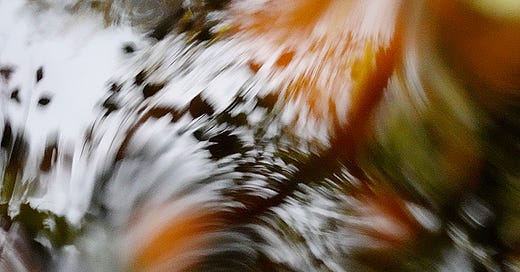



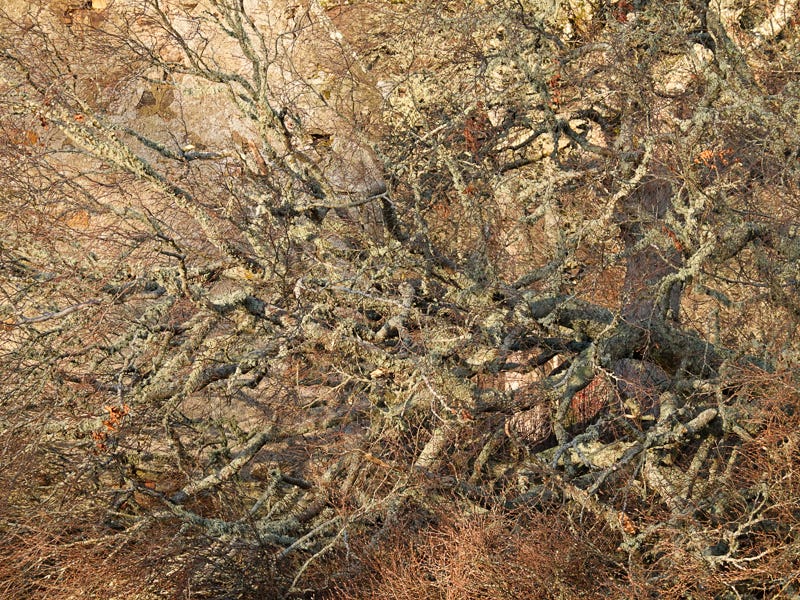
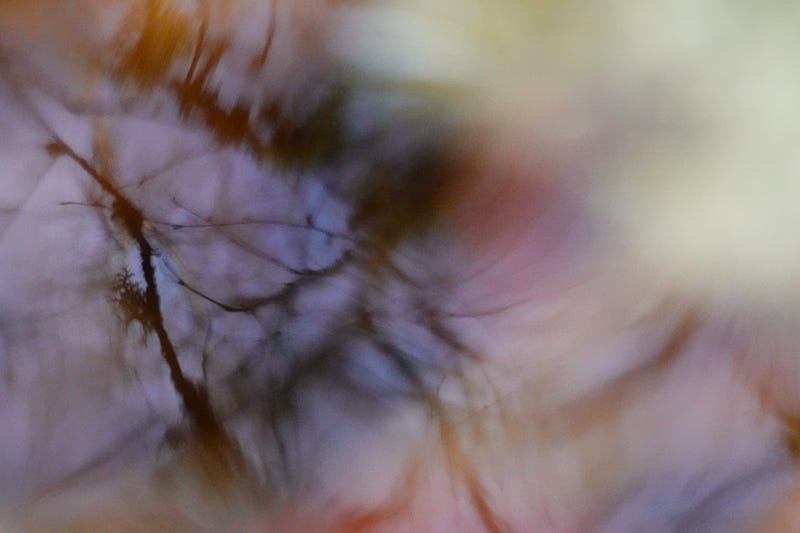
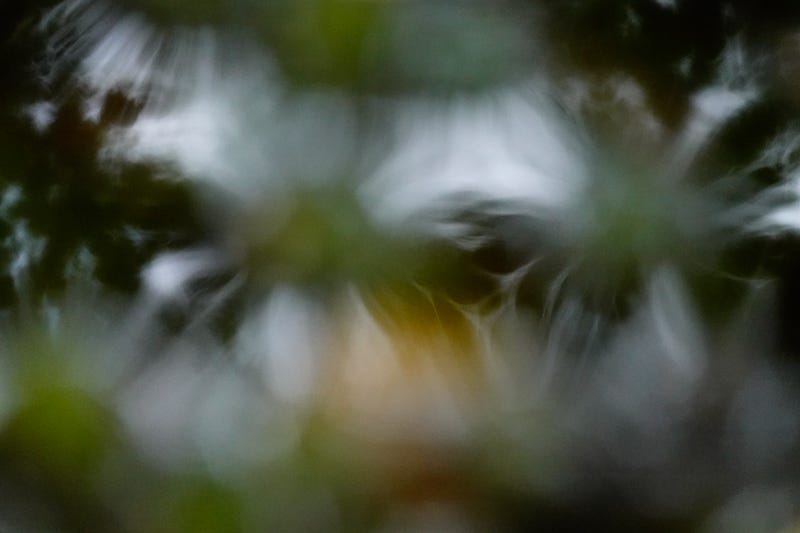


Hi Michela ,
I am loving and benefitting from your words and vision. My way of looking has definitely changed over time. I look downwards much more now. I like to celebrate the details, the un-noticed, the everyday. But I like to re-imagine these elements into something else as well. I don't have to look at the world in literal fashion. Thank you for promoting me to think about this.
Hi Michaela, love your posts, very thought provoking! As a painter of landscapes I couldn`t work out why I have lost my `oomph` for painting recently, until I realised that my interest has changed from the bigger picture to becoming fascinated by the smaller elements within the scene, the textures of fences, hedges, lichens etc. My eyesight has changed with age which may have affected this but I`m now left with needing a new way to express this interest in my work, probably moving more to printing which is a complete change of direction for me.